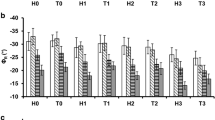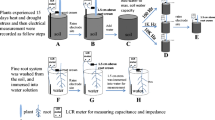Abstract
THERE is no adequate method to distinguish a functional root from a non-functional or presumably dead root. An electrical technique has been used1 to diagnose the vitality of portions of roots of some weeds by measuring the resistance and capacitance of the tissue. Vital staining, in many cases with triphenyl tetrazolium chloride, has also been used for seedlings of grasses such as rice2. These methods, however, can only be used when the root is thick enough to allow insertion of an electrical probe into tissues or when the root is so young that a stained portion may be easily seen.
Similar content being viewed by others
References
Greenham, C. G., and Cole, D. J., Austral. J. Agric. Res., 1, 103 (1950).
Aimi, R., and Fujimaki, K., Proc. Crop Sci. Soc. Jap., 27, 21 (1958).
Williams, R. D., Ann. Bot., 28, 419 (1964).
Author information
Authors and Affiliations
Rights and permissions
About this article
Cite this article
UENO, M., YOSHIHARA, K. & OKADA, T. Living Root System distinguished by the Use of Carbon-14. Nature 213, 530–532 (1967). https://doi.org/10.1038/213530b0
Issue Date:
DOI: https://doi.org/10.1038/213530b0
- Springer Nature Limited
This article is cited by
-
Estimation of the distribution of living roots of plants under field conditions
Plant and Soil (1973)
-
Root distribution and the cause of its spatial variability inPseudotsuga taxifolia (Poir.) Britt.
Plant and Soil (1970)





